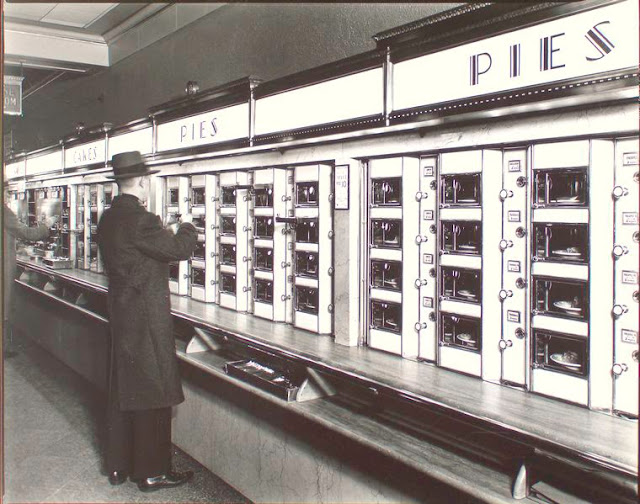From automata to tavola rustica
For some whose life is now largely on the net, the existence of the doorman at Tavern on the Green, and his demise, won't mean much. That was then. Don't need doormen on the Web, nor the protocol of subordination that the uniform brought to bear upon every opening of the door.
Lots of rhetorical gestures are equally de trop -- corporate websites, with their elaborate flash "intros" that everyone skips. It is nothing new to note that we want small, speedy, light, functional modes. Use over exchange -- spare the sizzle, just the steak, etc.
The thingliness of dead protocols just makes them more dead, doesn't it? But then there's the return of all that in archives available to all - (those that are "private" are simply JSTORized out of common reality) - e.g., in this magnificent NYPL collection of Abbott photos of New York of the 30s:
"The machines were filled from the kitchen behind." wp
The arc of that time - dazzling technological innovation taking place in a time of impoverishment -- putting mechanical turks behind columbaria of nourishment so as to make the users seem empowered, the workers seem invisible, and the delivery of what was to be consumed appear a sort of humorous point-and-click anticipation of what we now consider pretty nifty technology -- an arc of technological advance which, by 1965, had arrived at a state of seedily dehumanized, tinfoil-hatted industrial inspiration.
Abbott's New York of 1935, at the peak of Horn and Hardartian sheen, looks at us through Manhattan's penury accompanied by a world of human presence - a place of art, and readers, and cats and placid brooms.
Neither the emblazoned Tavern nor the Foodomat seem especially appealing, comfortable, or contemporary, though for completely opposed reasons. But with these guys, I could feel at home.
Labels: automated targeting, Berenice Abbott, contemporaneity, economy, New York City, New York Public Library, Tavern on the Green, unemployment





0 Comments:
Post a Comment
<< Home